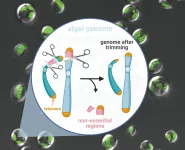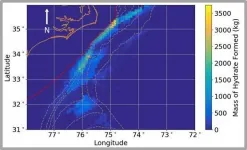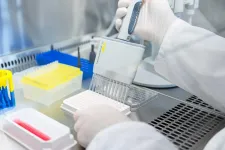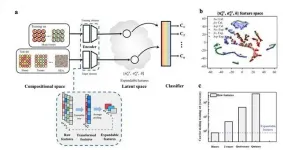INFORMATION:
Genome scalpel invented for industrial microalgae to efficiently turn CO2 into biofuel
2021-03-17
(Press-News.org) A single-celled alga undergoes genome surgery to remove non-essential parts. This can lead to a most efficient cellular factory for producing sustainable biofuels from sunlight and carbon dioxide.
Researchers from the Qingdao Institute of BioEnergy and Bioprocess Technology (QIBEBT) of the Chinese Academy of Sciences (CAS) have stripped hundred-kilobase genome from a type of oil-producing microalgae, knocking out genes non-essential for it to function. By doing so, they have created a "genome scalpel" that can trim microalgal genomes rapidly and creatively.
The 'minimal genome' microalgae produced is potentially useful as a model organism for further study of the molecular and biological function of every gene, or as a 'chassis' strain for synthetic biologists to augment for customized production of biomolecules such as biofuels or bioplastics.
The study was published in The Plant Journal on March 14, 2021.
Creation of a 'minimal genome' -- a genome stripped of all duplicated or apparently non-functional 'junk genes' -- can be very useful for investigating fundamental questions about genetic function and for designing cell factories that produce valuable compounds.
Such minimal genomes have been created for simple organisms, but rarely for eukaryotic organisms, including algae or plants. In higher eukaryotes, "junk" regions can take up to 70 percent of the genome. Deleting what only appears to be "junk genes" in fact can have harmful effects on the organism or even kill it.
For the first time, researchers from QIBEBT have produced a genome with targeted deletions, of hundred kilobases in size each, for a type of algae called Nannochloropsis oceanica.
N. oceanica are microalgae (single-celled algae) that have tremendous potential for production of biofuels, biomaterials and other platform chemicals in a renewable and sustainable manner while reducing greenhouse gas emissions. However, realizing the potential of these microalgae requires extensive genetic engineering of the organism to maximize yields and minimize production costs.
The QIBEBT team first identified the non-essential chromosomal regions -- ones whose genes were rarely expressed, or activated. They identified ten such 'low-expression regions', or LERs. They then used CRISPR-Cas9 gene-editing technique to snip out two of the largest LERs -- over 200 kilobases in size.
"Despite the all snipping, the microalgae still showed essentially normal growth, lipid content, fatty acid saturation levels and photosynthesis," said study first-author WANG Qintao, of the Single-Cell Center (SCC) in the QIBEBT. "In some cases, there was even a slightly higher growth rate and biomass productivity than the organism in the wild."
"We interestingly found normal telomeres in the telomere-deletion mutants of Chromosome 30," said the corresponding author XU Jian, of the SCC in QIBEBT. "This phenomenon implies the losing of distal part of chromosome may induce telomere regeneration."
Already, the substantially snipped genome should serve as a closer-to-minimal genome in Nannochloropsis, which can serve as the chassis strain for customized production of biomolecules using further metabolic engineering atop this chassis.
Now that they have proven they can strip down the genome of such a complex eukaryote, the researchers now want to see if they can snip out still further LERs and other non-lethal regions, to craft a fully minimal Nannochloropsis that makes biofuels from CO2 with the highest efficiency.
ELSE PRESS RELEASES FROM THIS DATE:
Modeling the probability of methane hydrate deposits on the seafloor
2021-03-17
RALEIGH, N.C. -- Methane hydrate, an ice-like material made of compressed natural gas, burns when lit and can be found in some regions of the seafloor and in Arctic permafrost.
Thought to be the world's largest source of natural gas, methane hydrate is a potential fuel source, and if it "melts" and methane gas is released into the atmosphere, it is a potent greenhouse gas. For these reasons, knowing where methane hydrate might be located, and how much is likely there, is important.
A team of researchers from Sandia National Laboratories and the U.S. Naval Research Laboratory have developed a new system to model the likelihood of finding methane ...
Cambodian study assesses 3D scanning technologies for prosthetic limb design
2021-03-17
Cutting-edge 3D scanners have been put to the test by researchers from the University of Southampton and partners Exceed Worldwide to help increase the quality and quantity of prosthetics services around the world.
The study, carried out within the END ...
What brings olfactory receptors to the cell surface
2021-03-17
A team of scientists led by Dietmar Krautwurst from the Leibniz Institute for Food Systems Biology at the Technical University of Munich has now identified address codes in odorant receptor proteins for the first time. Similar to zip codes, the codes ensure that the sensor proteins are targeted from inside the cell to the cell surface, where they begin their work as odorant detectors. The new findings could contribute to the development of novel test systems with which the odorant profiles of foods can be analyzed in a high-throughput process and thus could be better controlled.
The ...
Crystal structure prediction of multi-elements random alloy
2021-03-17
Alchemy, which attempted to turn cheap metals such as lead and copper into gold, has not yet succeeded. However, with the development of alloys in which two or three auxiliary elements are mixed with the best elements of the times, modern alchemy can produce high-tech metal materials with high strength, such as high entropy alloys. Now, together with artificial intelligence, the era of predicting the crystal structure of high-tech materials has arrived without requiring repetitive experiments.
A joint research team of Professor Ji Hoon Shim and Dr. Taewon Jin (first author, currently at KAIST) of POSTECH's Department of Chemistry, and Professor Jaesik Park of POSTECH Graduate School of Artificial Intelligence have together developed a system that predicts ...
Not just for numbers: Anchoring biases decisions involving sight, sound, and touch
2021-03-17
TROY, N.Y. -- Numeric anchoring is a long-established technique of marketing communication. Once a price is mentioned, that number serves as the basis for -- or "anchors" -- all future discussions and decisions. But new research shows that this phenomenon is not limited to decisions that involve numbers, the use and understanding of which require high-level cognitive thinking. Anchoring also biases judgments at relatively low levels of cognition when no numbers are involved.
In research recently published in the Journal of Behavioral Decision Making, Gaurav Jain, an assistant professor in the Lally School of Management at Rensselaer Polytechnic Institute, demonstrated that anchoring even occurs in perceptual domains, ...
FAU researchers break bonds in molecular nitrogen with calcium
2021-03-17
Chemists all over the world are constantly searching for simple ways to make elemental nitrogen or N2 in the air available for chemical reactions. This is no easy task, as nitrogen is a particularly non-reactive gas with a triple bond, which is one of the strongest known chemical bonds. A research team at Friedrich-Alexander-Universität Erlangen-Nürnberg (FAU) has now demonstrated that calcium, a metal commonly found in nature, is able to break the highly-stable nitrogen bond and can do so at minus 60°C. This is significant for two reasons. On the one hand, the researchers at FAU have made a new discovery in terms of the bond-breaking capabilities of calcium, which had been largely disregarded in the past. On ...
It's snowing plastic
2021-03-17
The snow may be melting, but it is leaving pollution behind in the form of micro- and nano-plastics according to a McGill study that was recently published in Environmental Pollution. The pollution is largely due to the relatively soluble plastics found in antifreeze products (polyethylene glycols) that can become airborne and picked up by the snow.
The researchers used a new technique that they have developed to analyze snow samples collected in April 2019 in Montreal for both micro- and nano-sized particles of various plastics. The McGill technique is orders of magnitude more sensitive than any of the other current methods used for tracing plastic in the environment. It ...
Certain mouthwashes might stop COVID-19 virus transmission
2021-03-17
Researchers at Rutgers School of Dental Medicine have found evidence that two types of mouthwash disrupt the COVID-19 virus under laboratory conditions, preventing it from replicating in a human cell.
The study, published in the journal Pathogens, found that Listerine and the prescription mouthwash Chlorhexidine disrupted the virus within seconds after being diluted to concentrations that would mimic actual use. Further studies are needed to test real-life efficacy in humans.
The study was conducted in a lab using concentrations of the mouthwash ...
Advisory: Study confirms vitamin D, fish oil don't lower atrial fibrillation risk
2021-03-17
A study published March 16 in JAMA (the Journal of the American Medical Association) confirms that neither vitamin D nor the omega-3 fatty acids found in fish oil prevent the development of atrial fibrillation (AF), a potentially serious heart rhythm disturbance. The newly published research follows a presentation made by Christine Albert, MD, MPH, at the American Heart Association Scientific Sessions last year.
In their JAMA analysis, Albert and her research team also examined whether vitamin D or omega-3 fatty acids might have an impact on paroxysmal versus persistent atrial ...
Semiconductor nanogrooves enhanced broad spectral band mmW and THz detection
2021-03-17
Millimetre and terahertz wave detectors have a wide range of applications in areas such as communications, security, biological diagnosis, spectroscopy, and remote sensing. They are the components that can transform light information loaded by long-wavelength millimetre and terahertz waves into electrical signals. High-performance room-temperature detectors with high sensitivity, fast response, broad spectral bandwidth, and possibility to be extended to large format arrays are always pursued. They are the building blocks for a wide range of millimetre ...





